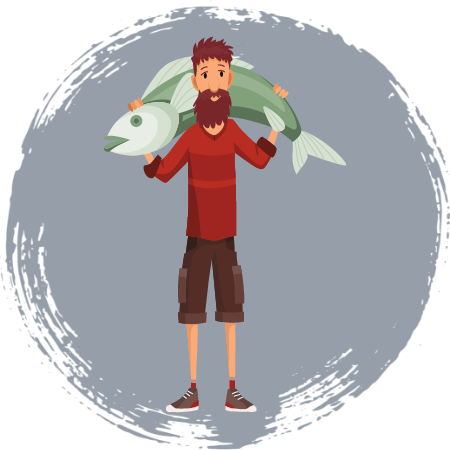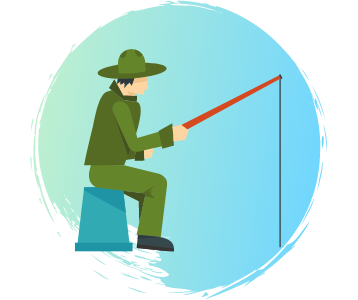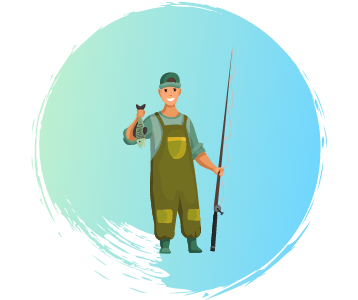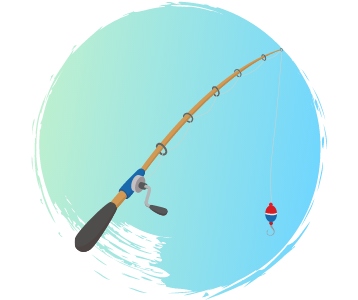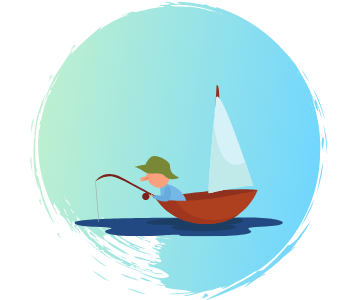Fishing Guides:
How To Catch Tripletail
Tripletail are hard to find, harder to catch, and above all, have delicious meat. They’re a widespread fish you can find in many different environments; however, most anglers who have seen them never know because of their excellent camouflage. If you’re interested in learning about how to catch these slippery beasts, this is the guide for you.
In this guide, we’ll go over:
- Tripletail Behavior Patterns
- Fishing Tactics
- Insider Tips
- Our Gear Recommendations
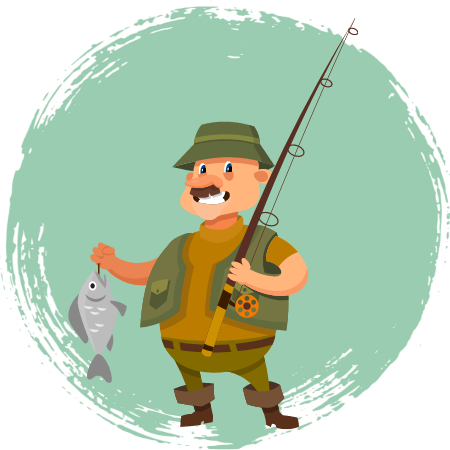
Chapter 1:
Tripletail Biology
The first thing you need to do to learn to catch a fish is knowing about it. It’s habits, how to identify it, what it eats, anything you can learn about it can be helpful. We’ll cover some of the essential parts in this section.
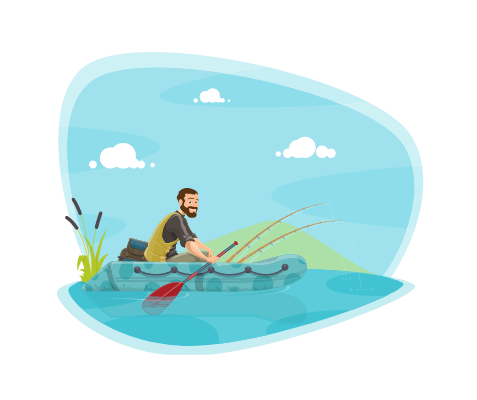
Where Can You Find Tripletail?
Tripletail are found throughout the Gulf of Mexico but are most common in Florida waters. They spend time in multiple environments, from bays and estuaries to beaches and even offshore. Tripletail will usually hang out floating underneath and around structures like weedlines, flotsam, and docks, or around the buoys marking traps. Sometimes they will let themselves drift in the currents and tides.
How To Identify Tripletail?
Tripletail get their name from the large rear fins that make it look like it has three tails. Also called blackfish, they have a tall, thick but flat body with a big bass-like mouth. Their head sticks off the front and slopes upwards towards their back.
In the water, the tripletail looks a lot like a floating piece of debris. Their tails and body-color look much like leaves, seaweed, and floating debris. Speaking of color, they can range from a wood-colored brown to silver and even a greenish color. In addition, they can range in size from around fifteen inches to well over forty pounds.
What Does Tripletail Usually Eat?
Tripletail are ambush predators that tend to float on their side underneath some sort of floating structure and wait on small prey to swim right by their mouths. They love shrimp and crabs but won’t turn up their noses at small baitfish that are unfortunate enough to pass by them.
Chapter 2:
Tripletail Fishing Tactics
Here we’ll discuss some of the finer points of targeting tripletail, including finding them, things to look out for, common tactics, general tackle choices, and best bait choices.
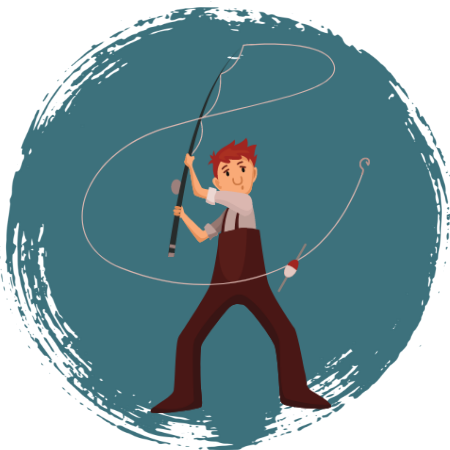
How To Find Tripletail
Tripletail are both challenging and easy to find at the same time. They stand out pretty quickly if you know what to look for, but it’ll take some practice if you’re unfamiliar. Look for floating body profiles around whatever structure you can find. Crab trap markers, marker buoys, weedlines, and random floating debris are usually your best bets, but any kind of floating structure is likely to hold a tripletail or two.
What To Avoid
When you pull up to a likely spot, you’ll want to go slowly. Tripletail spook easily, and rushing a boat up to them is a sure-fire way to run them off. Instead, cut the motor and even try to avoid using your trolling engine on approach. It’s also helpful to speak quietly and not stomp around the boat. Cast farther away from your target as smooth as possible and slowly bring your bait into range.
Common Tactics
One of the most challenging but most common ways to target tripletail is sight fishing. Move around a lot and check as many locations as possible until you spot the fish hanging around under the structures before casting a live bait beyond them and slowly bringing it closer.
General Tackle
You can go light or heavy for a tripletail, excellent depending on your personal preference. You’ll get a better fight on light tackle, but they’re known for darting around, so you’ll need good boat maneuvering to avoid tangling. A good setup is solid medium action, seven-foot rod, 4000 series reel, and between ten and twenty-pound test braided line.
Best Bait Options
Live bait is generally agreed as the best option for tripletail. It’s the most realistic option for them to take as they’re waiting on shrimp, crabs, and baitfish to drift past anyways. You can get away with lifelike lures and dead baits as well with varying degrees of success.
Chapter 3:
Insider Tips & Tricks

1. Tripletail can change colors to camouflage better.
Remember we talked about tripletail ranging in color from brown to silver? This is their ability to try to match the cover they’re hiding under and be less conspicuous. In all honesty, it usually helps them stand out to a person with a trained eye, making their profile stand out under the water. Expect a tripletail on a brownish weedline to be matching the color of those weeds. It’s why many anglers have probably seen one but not known at the time.
2. There’s usually only one fish on any structure.
It isn’t unheard of for there to be two tripletail under one structure, or even three at times, but it is rare. There’s usually only one fish in any promising spot, so if you catch one or spook it off, it’s time to move on. It’s unlikely you’ll get the second to bite if you hooked one already. In rare cases, there are two, but you can give it a go before leaving.
3. Be ready to be mobile.
You’re going to have to check a lot of spots to find a tripletail. They’re a really common fish, but not every buoy has one under it. It’s a numbers game, really, and the more spots you check, the higher the chances are you’ll find that big one to put in the freezer.
4. Don’t forget them on other trips.
Offshore trips to look for Mahi and blackfin on weedlines? Be on the lookout for a tripletail. Are you fishing farther away from the dock and passing by markers? Take the time and stop to look for a tripletail. You can make a good day better and a bad day good just by taking the time and looking out for a tripletail or two on the way.
5. Be quiet.
This rule extends to everything about tripletail fishing. You’ll want to drift up to them with all engines off. Cast as quietly as possible away from the structure and slowly bring your bait to them. Avoid making a ton of noise on board too. Stealth is the name of the game with these fish, and just as they hunt stealthily, the best way to hunt them is with stealth too.
6. Wait to set your hook.
Tripletail have hard mouths, and it takes a minute for them to swallow the bait. To get a solid hook set, give it a solid count to three before pulling to set the hook. Use a small circle hook that can set with pressure to avoid having to jerk the rod and risk pulling your bait out of their mouths.
Chapter 4:
Top Tripletail Fishing Gear

Rods
St. Croix Rods Mojo Bass Spinning Rod

Check Price on Amazon
St. Croix rods are renowned for quality and balance. The Mojo bass rods are a stiff beast of a rod that’s great for setting hooks on tripletail and has the balance you need for long silent casts. The medium/heavy, fast rods give you the rigidity necessary for tripletail fishing, and the quality of the rod makes it a joy to use.
13 FISHING Omen Black Spinning Rod

Check Price on Amazon
The Omen Black is a great all-around rod that can handle many different species and sizes of fish. It’s got outstanding balance and strength and has a few different handle styles for you to choose from to get a comfortable grip.
Reels
SHIMANO Stradic FL

Check Price on Amazon
The Stradic is well-known for being a quality reel that can fight big saltwater fish and perform for years. It’s got enough drag to handle a bigger tripletail, a smooth retrieval, and the reel sits close to the rod to help reduce casting fatigue on long fishing trips.
KastKing Summer and Centron

Check Price on Amazon
A good budget option for the Stradic is the KastKing Centron. It gives you all the power and durability of high-priced reels at a fraction of the cost. Packing in all the features you’d expect from brands with longer histories, KastKing reels are great options for anglers targeting any number of saltwater species.
Baits
For the most part, live bait is your best option. However, if you enjoy using artificial lures or don’t want to catch bait, you have some good options. Lifelike lures are your best option, but for tripletail, one stands out above the others.
LiveTarget Fleeing Shrimp Jig

Check Price on Amazon
The best of the best when it comes to lifelike lures, LiveTarget’s fleeing shrimp is the perfect choice for a tripletail. It’s an excellent mimic of a live shrimp anyways, and it moves through the water just as naturally as a shrimp would when it drifts past a hungry tripletail.
Chapter 5:
Final Thoughts
Tripletail are one of the highest quality table-fare fish you can get. These elusive and largely ignored fish become easier to find and target with a bit of knowledge, opening up a fantastic fishery that delivers excellent food and great fights with game fish.
